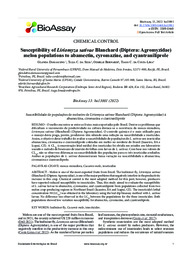Susceptibility of Liriomyza sativae Blanchard (Diptera: Agromyzidae) melon populations to abamectin, cyromazine, and cyantraniliprole.
Susceptibility of Liriomyza sativae Blanchard (Diptera: Agromyzidae) melon populations to abamectin, cyromazine, and cyantraniliprole.
Author(s): DAMASCENO, D.; SILVA, I. C. DA; BERNARDI, O.; COSTA-LIMA, T. C. da
Summary: Melon is one of the most exported fruits from Brazil. The leafminer fly, Liriomyza sativae (Blanchard) (Diptera: Agromyzidae), is one of the major problems that negatively interfere in the productivity increase in this crop. Chemical control is the most adopted method for this pest; however, producers have reported reduced susceptibility to insecticides. Thus, this study aimed to evaluate the susceptibility of L. sativae larvae to abamectin, cyromazine, and cyantraniliprole from populations collected from two melon crop-producing regions in Northeast Brazil (Juazeiro, BA and Icapuí, CE). The insecticide?s lethal concentration 50 (LC50) was obtained in the laboratory using the leaf dip bioassay method with L. sativaelarvae. No difference was observed in the LC50 between the populations for the three insecticides. Both populations showed low variation susceptibility for abamectin, cyromazine, and cyantraniliprole.
Publication year: 2022
Types of publication: Journal article
Unit: Embrapa Semi-arid Region
Observation
Some of Embrapa's publications are published as ePub files. To read them, use or download one of the following free software options to your computer or mobile device. Android: Google Play Books; IOS: iBooks; Windows and Linux: Calibre.
Access other publications
Access the Agricultural Research Database (BDPA) to consult Embrapa's full library collection and records.
Visit Embrapa Bookstore to purchase books and other publications sold by Embrapa.

